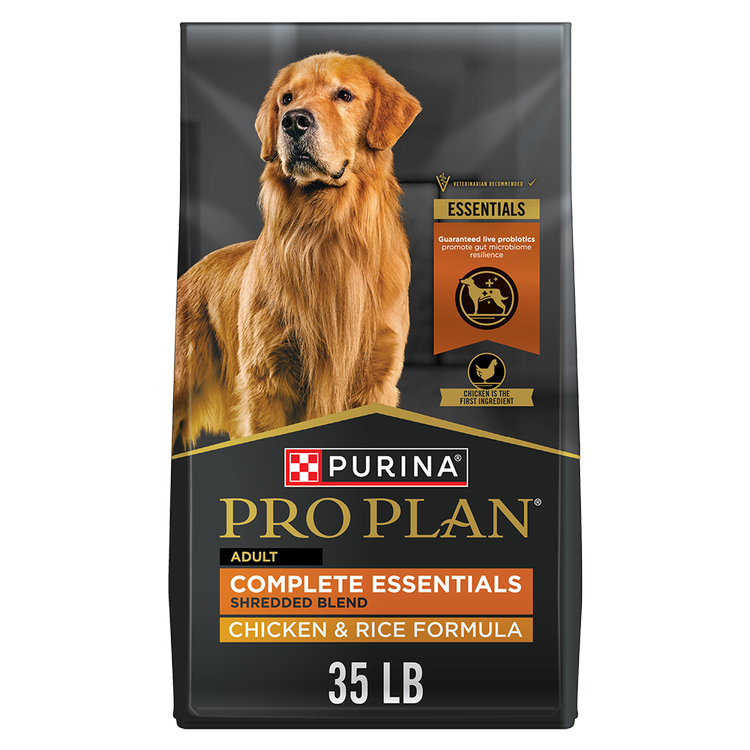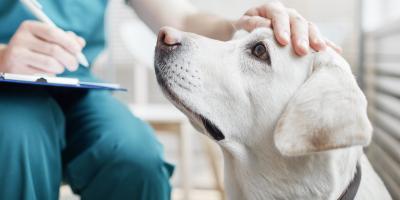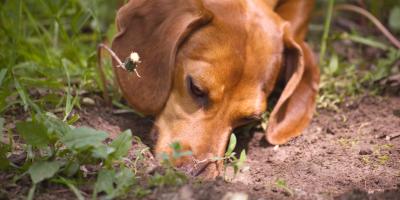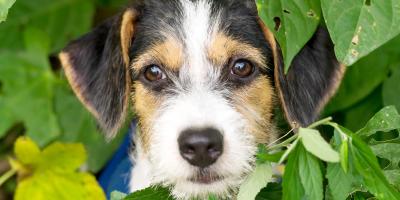If you’re wondering how to groom a dog, you can get started at home with a little knowledge and some tools.
Your pet may like it as well. Establishing an in-house grooming routine can be comforting, while promoting their health and quality of life. They may also get some extra praise, pets, and positive-reinforcement; if you’re going to provide treats, remember not to provide more than 10% of daily kcals/calories.
Grooming also lets you visually detect signs of potential issues that may require your veterinarian’s attention.
Here’s our guide on how to groom a dog at home.
How to Cut Dog Hair
If you’re curious about how to cut dog hair, you may first want to consider getting professional-grade clippers and scissors. The superior construction will likely make your job easier.
Clippers are sized by number. A lower number-blade can cut hair shorter, while a higher number will leave it longer. Ask your veterinarian for a recommendation that’s right for your dog.
You may also want to use guide combs with your clippers. These provide a layer of safety because they keep the blade away from the skin.
Follow these steps to clip your dog's hair:
Give your dog a thorough brushing, combing through all tangles and mats.
Choose a safe, comfortable place to clip hair. Keep in mind that your dog may want to move during the process, especially if it’s the first time.
Starting with a higher-number blade, clip away longer hair and hair in sensitive areas. Keep the blade flat against the body.
Based on recommendations from your veterinarian or a groomer, choose a blade length that corresponds to how long you want your dog’s hair to be. When choosing a direction, one option is to clip from head to tail or shoulders and hips to paws.
During the clipping process, be sure to monitor the blade and make sure it’s not getting too hot from the friction of movement, which can cause discomfort and, in some cases, burn pets' skin.
After you finish clipping, brush your dog and check for uneven patches of hair; re-do these areas. For their head, tail and paws, scissors are recommended.
How to Deshed a Dog
If you’re constantly finding dog hair around your home, you might be wondering how to deshed a dog. Regular brushing is key to deshedding as it removes older hair before it has a chance to fall off your dog. Bathing can help, too.
You might find deshedding tools to be useful as well. Whether it’s a blade with serrated teeth or brush with steel tines, these tools are designed to clear away excess loose or older hair.
Ask your veterinarian if they recommend a specific model or brand.
Brushing Your Dog
Brushing is one of the easiest ways to bond with your dog. It helps cut down on shedding and depending on the brush, your dog might really enjoy it. Use the proper brushes, combs or rakes, depending on your dog’s breed (your veterinarian or a groomer may have recommendations).
Some dogs may require more brushing or combing than others, such as double-coated (Labradors, Beagles, Huskies, etc.) and long-haired breeds.
To get started, gently brush from head to toe to make it a relaxing, productive experience for the both of you.
Bathing Your Dog
If you want to know how to groom a dog to keep your pet clean, resist the urge to give frequent baths. Excessive bathing can cause dry skin and coat.
How often you bathe your dog depends on things such as coat type, lifestyle or specific health conditions.
You can also use the smell test to determine if it’s time for another bath—just smell them to see if there’s an offensive odor.
For some dogs, getting a bath can cause anxiety or frustration. A few tactics can help manage stress during bathing, however.
Here’s what you’ll need to get started:
- Treats (remember not to provide excess kcals/calories in treat form)
- Dog brush, comb, rake, etc.
- Dog-safe shampoo (deshedding shampoos for double-coated breeds)
- Dog-safe conditioner (for long-haired dogs and deshedding conditioner for double-coated breeds)
- Rinsing cup (if you don’t have a removable showerhead)
- Non-slip mat
- Plenty of towels
- Air force blower to blow out the double-coated breeds (if accessible and if the dog is used to it)
- Helper (if available)
- A pair of old clothes for yourself and your helper
The key to a successful bath is preparation. After you’ve gathered supplies, you’ll want to prep the space.
Make sure all of your supplies are in the bathing area. Have the bath water ready, too, placing the nonslip mat in the tub or sink. Also, check the water to ensure it’s at a comfortable temperature. We recommend testing the temperature with the underside of your wrist.
Next, prep your dog. Brush to help remove loose hair, debris and tangles. When done, invite your helper and your dog into the room and shut the door.
Begin by gently placing your dog in the tub or sink. Wetting their body slowly, start at the back legs to get them acclimated.
Offering a treat as things get started may be a great way to distract them.
Wash and condition according to the instructions on the product labels. Rinse thoroughly, making sure hair is free of all products to help prevent skin irritation. Take extra care around the eyes and ears to prevent irritation and excess water entering the ear canal.
When bathing is complete, towel dry your dog as much as possible before releasing them. If you have access to a dog air force blower, and your dog is used to it, begin to slowly blow out their fur.
Start at the hind limbs and slowly move forward, paying close attention to their behavior. If the blower is stressful, then towel dry as best you can. Brush them when they are dry.
Cleaning Your Dog’s Ears
Ear health and cleanliness are very important, so it’s a good idea to clean your dog’s ears regularly.
Here’s what you’ll need to get started:
- Cotton ball
- Vet-approved ear cleaning solution
- Dog ear cleaning wipes
- Treats
Use the cotton ball and solution, or the wipes, to wipe down all the visible skin that you can reach. Do not use the same cotton ball or wipe for both ears. This prevents spreading an infection if one ear is already infected. Using cotton swabs is not recommended as this may damage your dog’s ears unless instructed to by your veterinarian.
If your cotton ball is excessively dirty when you’re done, then you’ll want to take your dog in to see a professional for a closer look. Also, look out for red ears, odors or signs of inflammation.
Your dog may not be comfortable having their ears touched. So be very gentle and offer a treat or provide some other positive reinforcement when the job is done.
Dog Dental Hygiene
Like ear cleanliness, maintaining dental health in dogs is essential. It helps cut down on bacteria, preventing infections that can lead to more serious issues.
While formal checkups and cleanings by your veterinarian are recommended, regular brushings at home can help avoid or potentially reverse dental disease.
So can providing your dog with dental chews and therapeutic foods developed specifically to help reduce plaque or tartar buildup.
Learn more about how to clean your dog’s teeth, including steps for brushing.
Trimming Your Dog’s Nails
If you’re curious how to groom a dog, you may be wondering about nail trimming. It’s important as trim nails can keep your dog comfortable. It also helps protect your furniture, floors and body from scratches.
Trimming your dog’s nails at home can be intimidating for some, so here are some tips that may make it easier than you imagined (you can also ask your veterinarian or a groomer for guidance).
Before you start, engage in contact with their paws during a few play sessions to get them used to having both their paws and nails handled when they're puppies.
When you and your dog are ready for a nail trimming session, consider recruiting a friend to help.
Here’s what you’ll need to get started:
- Trimmers
- Styptic powder or cornstarch
- A helper
- Treats
First, head to a comfy spot with your supplies, your helper and your dog.
Next, let your dog sniff the trimmers as you and your helper get positioned for the nail trimming session.
Pet your dog and offer treats until they’re relaxed. Now it’s time to gently go in with the clippers and trim only the tip of the nail.
When trimming your dog’s nails at home, be extremely careful not to cut the nail’s quick. The quick has nerve endings and blood vessels that shouldn’t be cut.
The quick may be easier to see if your dog’s nails are light. It will likely appear as a pink line and might be seen through the sides of the nail.
If your dog’s nails are dark, you may have a hard time identifying the quick. Check the length of each nail by examining it head-on. If you see a small, dark dot in the middle of the nail, stop trimming.
If you accidentally cut into the quick and the nail starts to bleed, immediately apply pressure. Dip the nail in styptic powder or cornstarch if the bleeding doesn’t stop.
Only trim one to two paws at a time, keeping sessions short. Additionally, always use a gentle voice and positive praise during each at-home grooming session to put your pet at ease.
How to Trim Puppy Nails
Cutting puppy nails is similar to trimming those of an adult dog. Start by asking your veterinarian or professional groomer to recommend a good pair of clippers.
After slowly introducing your young dog to the clippers, gently hold their paw and locate the quick, if possible. Clip the nails conservatively, avoid the quick, and don’t hesitate to finish the job over multiple sessions if your pet seems anxious.
If you want to know how to groom a dog at home, you may feel challenged at first. Once you and your pet get used to it, however, grooming can be a positive, relaxing experience for both of you.
Want more health tips for dogs? Visit our Pet Expertise page for advice from our experts.
Related articles

Reward Yourself with myPurina
Earn and redeem rewards for Purina products with the myPurina app.








